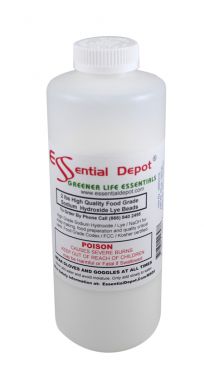I have another tip about lye masterbatching. Suppose you have a container ready for your masterbatch. How do you to figure out how much NaOH and water will just fit in that storage container? Here's how you can do this --
Turn on your scale, put the jug on the scale, and tare the scale so it reads zero with the jug on the scale.
Decide how full the jug should be. I don't fill my jug to the brim because a full container is hard to pour without drips and dribbles.
Fill the jug to the desired level with regular water.
Weigh the container + water. Record that weight -- this is the water weight.
Tip -- Now is a good moment to practice pouring out of the jug to make sure you can comfortably hold the full jug and pour without dribbling. If you can't do it with water, it will be a struggle when the jug is full of lye solution.
Multiply the water weight by 1.5 --
50% NaOH Masterbatch weight = Water weight X 1.5
Divide the masterbatch weight by 2 to get the weights of the dry NaOH and water needed to make the masterbatch solution --
Masterbatch water weight = Masterbatch weight / 2
Dry NaOH weight = Masterbatch weight / 2
Make the masterbatch solution as described by Irish Lass (see Earlene's link, above).
Remember -- 50% NaOH solution is
HEAVY. It's 1.5 times as heavy as water. Think about that when you decide how much masterbatch solution you want to put in your jug. Don't overfill it to avoid drips and dribbles. And don't overfill it to keep the weight manageable.
Comment -- for those who are comfortable with math, the formulas above can certainly be simplified. I didn't so everyone can follow the process.
You're going to love master-batching your lye and working based on lye concentrations.






